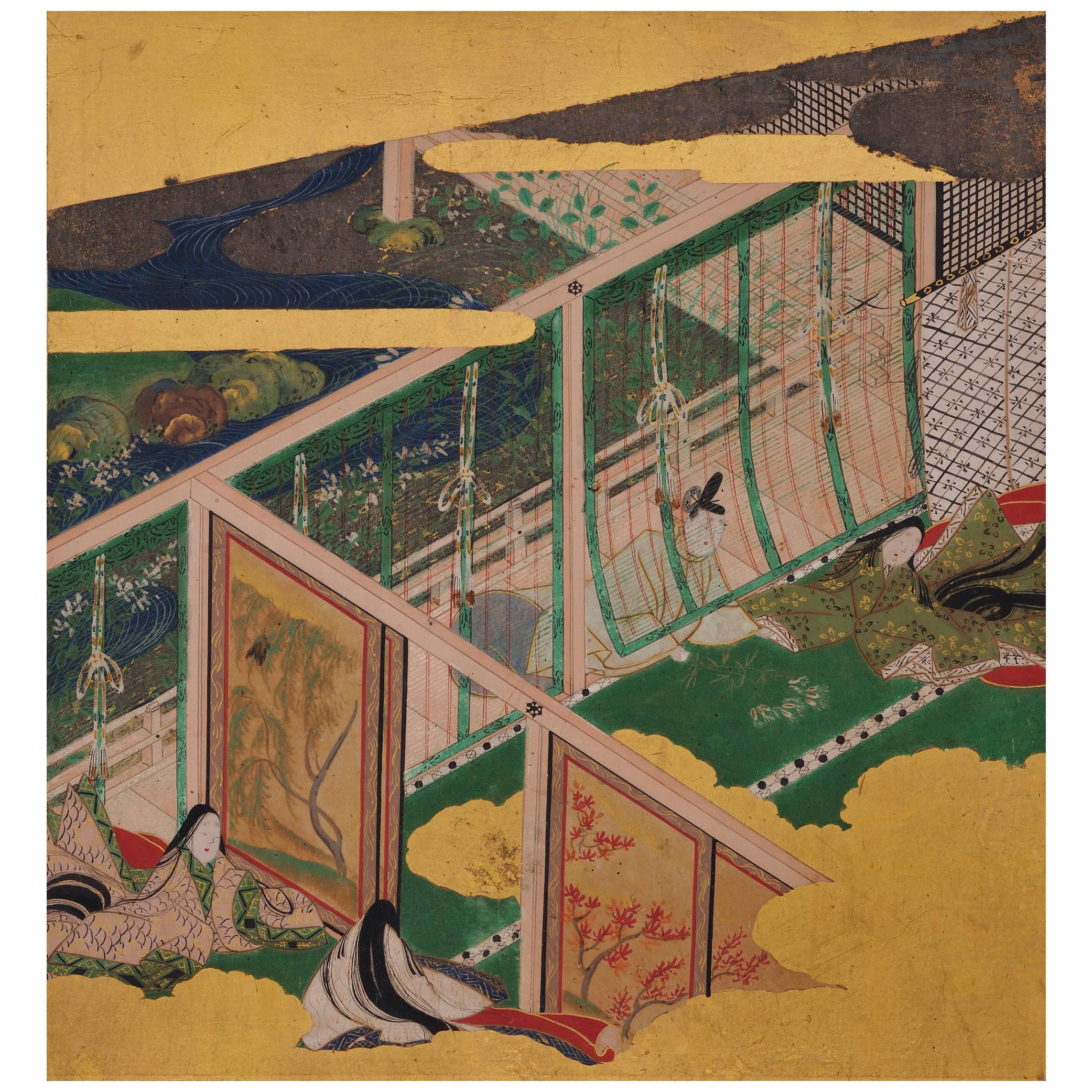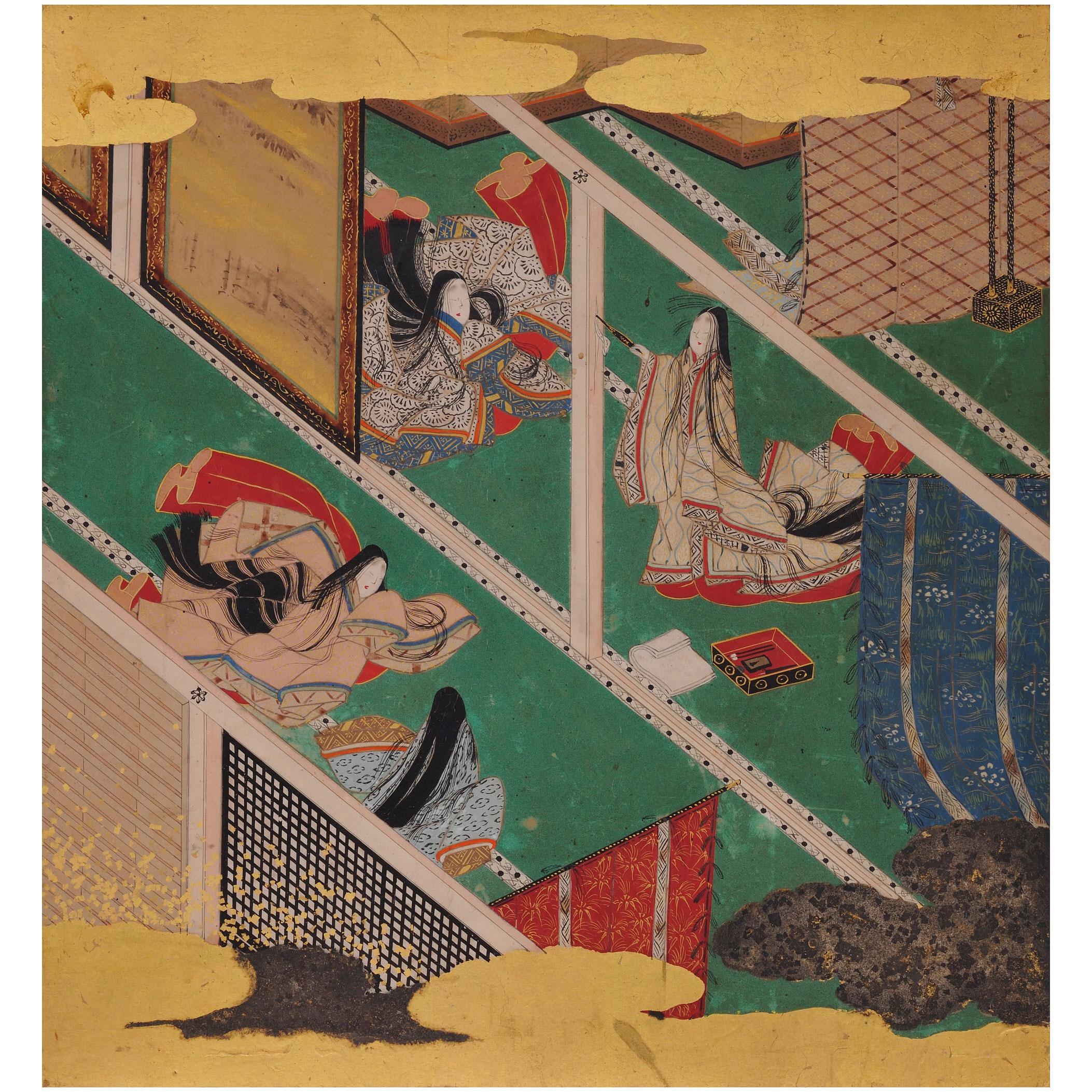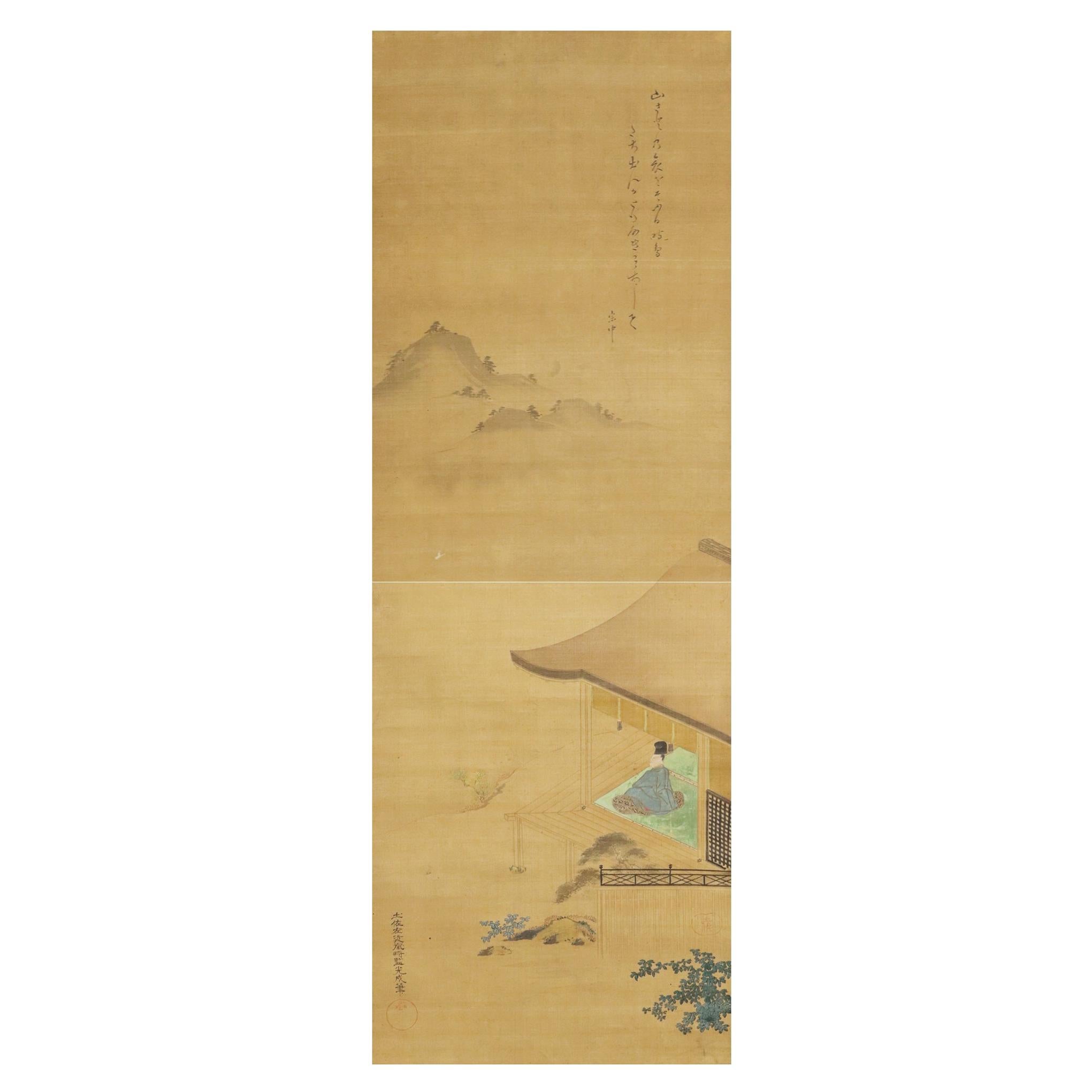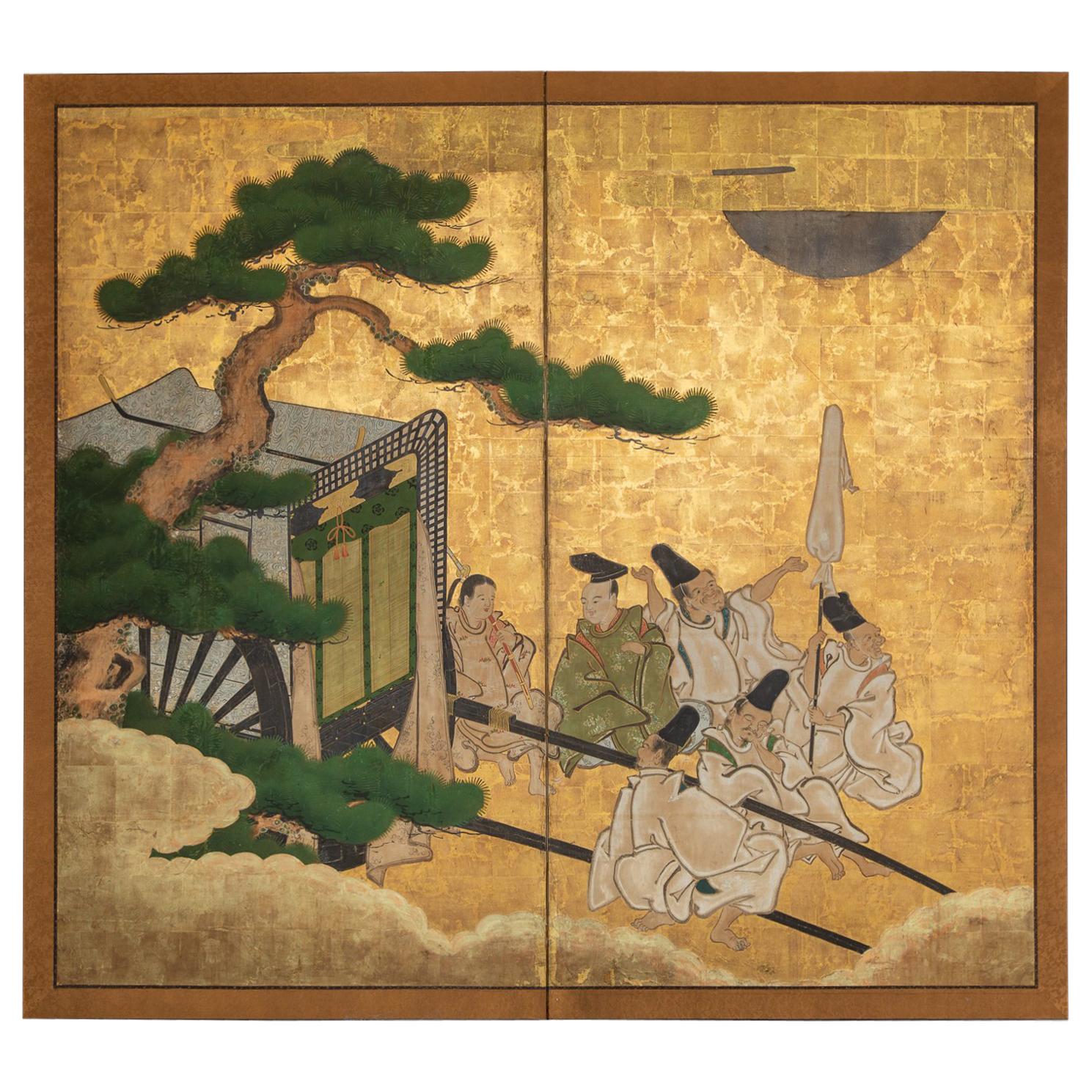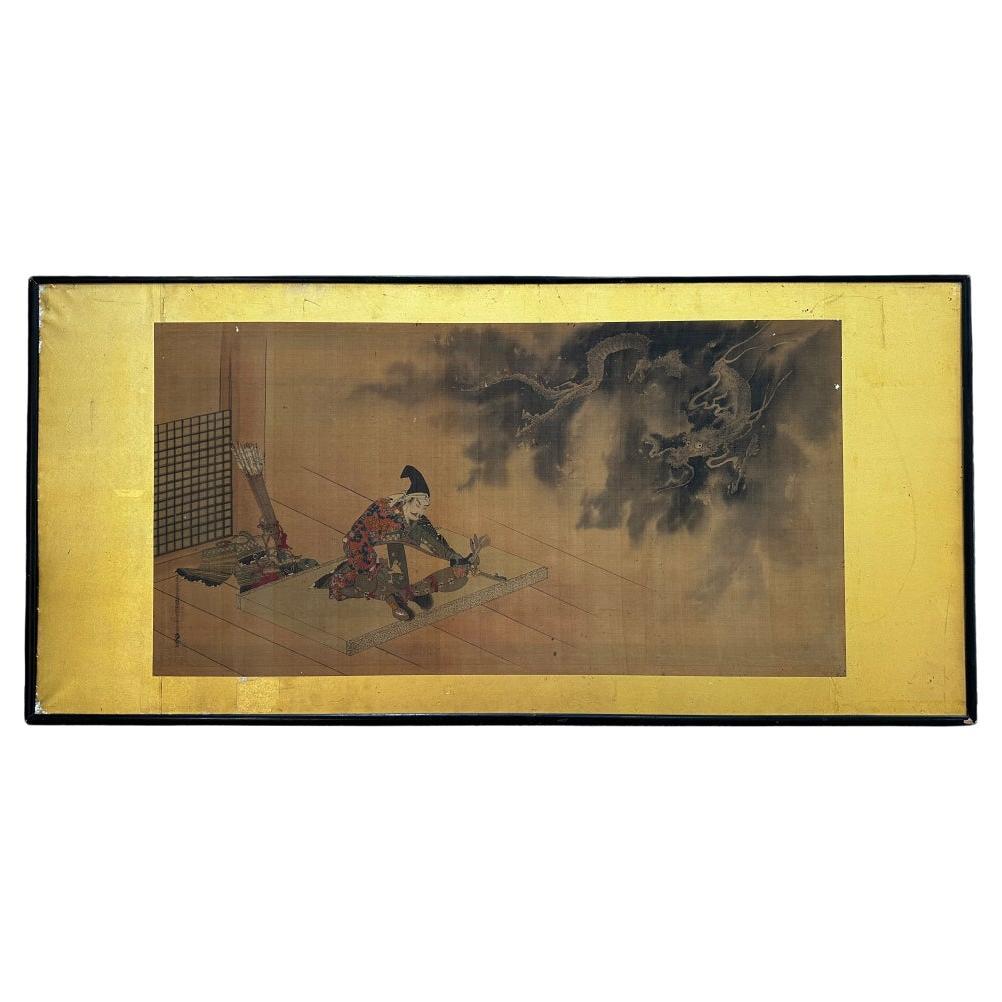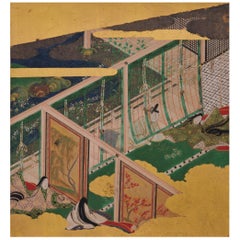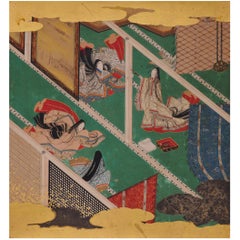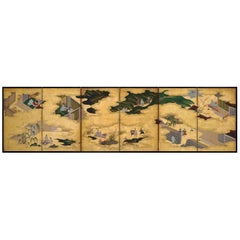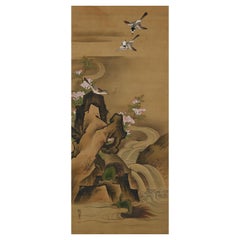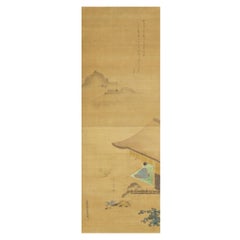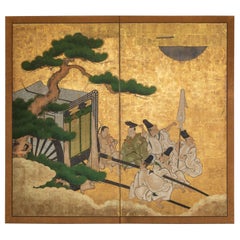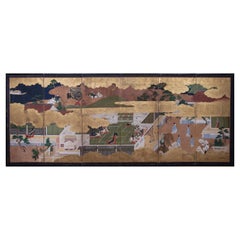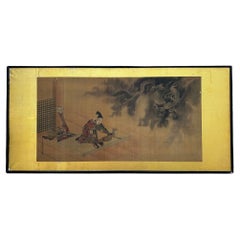Items Similar to Japanese Painting, 17th Century, Tale of Genji, Tosa School
Want more images or videos?
Request additional images or videos from the seller
1 of 5
Japanese Painting, 17th Century, Tale of Genji, Tosa School
$3,200
£2,446.57
€2,817.95
CA$4,484.18
A$5,006.17
CHF 2,623.16
MX$61,280.39
NOK 33,314.11
SEK 31,410.97
DKK 21,030.69
Shipping
Retrieving quote...The 1stDibs Promise:
Authenticity Guarantee,
Money-Back Guarantee,
24-Hour Cancellation
About the Item
Illustration to an unidentified chapter of the Tale of Genji (Genji Monogatari)
Tosa School (second half of the 17th Century)
Ink, pigment, gofun and gold on paper. Unframed.
Dimensions:
Approximately 17 cm x 15 cm (6.7” x 6”)
During the seventeenth century, Tosa School artists painted album leaves of Genji scenes in miniature. The viewer is rewarded on close inspection with the delicate facial features of the figures, the intricate patterns on drapery and clothing, and the careful depiction of various flowering trees and grasses. Viewed at a distance, the gold clouds and strong lines of the architecture in the different vignettes work together to form a unifying decorative pattern.
Presented here are individual album leaves from an incomplete set, each illustrating one chapter of the Tale of Genji. Exquisitely painted and beautifully preserved, they date to the second half of the 17th century. Roofs are entirely removed from houses to reveal small, doll-like figures within. Delicate flowers and plants suggest the seasons of the year. Surrounded by gilded clouds, these graceful paintings shimmer with uncommon beauty and delicacy.
One of the world's greatest literary masterpieces and the finest achievement of classic Japanese prose narrative, The Tale of Genji, written by Murasaki Shikibu shortly after 1000 A.D., has provided endless inspiration for Japanese painters throughout the centuries. The Tale of Genji weaves a vivid depiction of aristocratic life in Heian Japan, which centres on the amorous exploits and political gameplay of the nobility.
- Dimensions:Height: 6.7 in (17.02 cm)Width: 6 in (15.24 cm)Depth: 0.1 in (2.54 mm)
- Style:Edo (Of the Period)
- Materials and Techniques:
- Place of Origin:
- Period:Late 17th Century
- Date of Manufacture:circa 1650-1700
- Condition:Wear consistent with age and use.
- Seller Location:Kyoto, JP
- Reference Number:1stDibs: LU2472312688221
About the Seller
5.0
Recognized Seller
These prestigious sellers are industry leaders and represent the highest echelon for item quality and design.
Established in 2001
1stDibs seller since 2016
70 sales on 1stDibs
Typical response time: 6 hours
- ShippingRetrieving quote...Shipping from: Kyoto, Japan
- Return Policy
Authenticity Guarantee
In the unlikely event there’s an issue with an item’s authenticity, contact us within 1 year for a full refund. DetailsMoney-Back Guarantee
If your item is not as described, is damaged in transit, or does not arrive, contact us within 7 days for a full refund. Details24-Hour Cancellation
You have a 24-hour grace period in which to reconsider your purchase, with no questions asked.Vetted Professional Sellers
Our world-class sellers must adhere to strict standards for service and quality, maintaining the integrity of our listings.Price-Match Guarantee
If you find that a seller listed the same item for a lower price elsewhere, we’ll match it.Trusted Global Delivery
Our best-in-class carrier network provides specialized shipping options worldwide, including custom delivery.More From This Seller
View AllJapanese Painting, 17th Century, Tale of Genji, Fujibakama, Tosa School
Located in Kyoto, JP
Purple Trousers (Fujibakama), Illustration to Chapter 30 of the Tale of Genji (Genji Monogatari)
Tosa School (second half of the 17th century)
Ink, ...
Category
Antique Late 17th Century Japanese Edo Paintings and Screens
Materials
Gold Leaf
Japanese Painting, 17th Century, Tale of Genji, Makibashira, Tosa School
Located in Kyoto, JP
The Handsome Pillar (Makibashira), Illustration to Chapter 31 of the Tale of Genji (Genji Monogatari)
Tosa School (second half of the 17th Century)
I...
Category
Antique Late 17th Century Japanese Edo Paintings and Screens
Materials
Gold Leaf
Japanese Screen Painting, Circa 1700 'Tales of Ise' by Tosa Mitsusuke
By Tosa Mitsusuke 1
Located in Kyoto, JP
A six-fold Japanese screen by Tosa Mitsusuke (1675-1710), Japan 17th-18th century, Edo period.
The signature reads Shoroku-i ge Tosa sa Konoe Shogen Mit...
Category
Antique Late 17th Century Japanese Edo Paintings and Screens
Materials
Gold Leaf
19th Century Japanese Silk Painting by Kano Chikanobu, Turtles & Azalea
Located in Kyoto, JP
Birds & flowers of the seasons
Pheasants & plum in snow
Unframed painting. Ink, pigment and gofun on silk
Kano Chikanobu 1819-1888
Signature...
Category
Antique Mid-19th Century Asian Edo Paintings and Screens
Materials
Silk
Korean Painting, Wall Panel, 17th Century Ink Grapevine
Located in Kyoto, JP
Grapevine
Anonymous. Korean, 17th century.
Wall panel, ink on paper.
Upper seal:
Kou Kinun in
Lower seal:
Kaigen
Dimensions:
Measures: 98.5 cm x 29.5 cm (39” ...
Category
Antique 17th Century Korean Other Paintings and Screens
Materials
Wood, Paper
17th Century Japanese Screen. View of West Lake by Unkoku Toyo.
Located in Kyoto, JP
Unkoku Toyo (1612-1668)
View of West Lake
Pair of eight-panel Japanese Screens. Ink and gold wash on paper.
Dimensions: Each screen: H. 110 cm x W. 372 cm (43” x 147”)
This pair ...
Category
Antique Mid-17th Century Japanese Edo Paintings and Screens
Materials
Paper
You May Also Like
Tosa School ca 1700 Scene Edo Period Scroll Japan 17/18c Artist Tosa Mitsunari
Located in Amsterdam, Noord Holland
Around the middle of the Edo period, say to have been drawn in Tosa Mitsunari of the hands of the Tosa School,
the Heian period of person (noble?) Is watching the birds fly the gard...
Category
Antique 18th Century Japanese Edo Paintings and Screens
Materials
Silk
$2,457 Sale Price
20% Off
Japanese Two-Panel Screen, Shogun's Journey to Edo
Located in Hudson, NY
Kano school painting of nobles at rest (some yawning) under moonlit sky. Mostly likely a representation of the last story in the Ise Monogatari: chapter 16, Sekiya (The Gatehouse). A...
Category
Antique Mid-19th Century Japanese Paintings and Screens
Important Japanese six-fold screen depicting The Tale of The Genji, 17th century
Located in Amsterdam, NL
An important Japanese six-fold screen, depicting episodes from The Tale of The Genji
Edo period, 17th century
Ink and colour on gilded paper, H. 155 x W. 380 cm
The Tale of Genji...
Category
Antique 17th Century Japanese Edo Paintings and Screens
Materials
Paint, Paper
Elegant Edo period painting by Reizei Tamechika (1823-1864) 冷泉為恭
Located in Fukuoka, JP
Elegant Edo period painting by Reizei Tamechika (1823-1864)
Period: Edo
Size: 113x53 cm
SKU: PTA147
Indulge in the elegance of the Edo period with our superb painting on silk, a m...
Category
Antique 19th Century Japanese Edo Paintings and Screens
Materials
Gold Leaf
Japanese Two-Panel Kanō Screen -Tale of Genji & Cherry Blossoms
Located in Greenwich, CT
Japanese Two-Panel Screen Kanō school, depicting a scene from the Tale of Genji , with various noble ladies and gentlemen in a landscape of cherry Blossoms - ink, colors and gold ...
Category
Antique Late 19th Century Japanese Meiji Paintings and Screens
Materials
Wood, Paper
Lovely Japanese 18th-19th Century Edo or Meiji Scroll Painting Japan
Located in Amsterdam, Noord Holland
Maruyama–Shijo style painting
C0ndition; Good but some stains.
Overall dimensions: width of about 28.2 cm and Length of about 173.8 cm
Painting width of about 25.5 cm × leng...
Category
Antique 19th Century Japanese Meiji Paintings and Screens
Materials
Bronze
$661 Sale Price
20% Off
More Ways To Browse
Antique Japanese Painting
Japanese Weaving
Small Dolls
Japanese Roof
Gilded Screen
Asia Dolls
17th Century Japanese Paintings
Miniature Screen
Doll House Furniture
Doll Houses
Antique Paper Dolls
17th Century Japanese Screens
Half Doll
Tale Of Genji
Genji Painting
Tosa School
Japanese Tosa School
Tale Of Genji Japanese Screen
